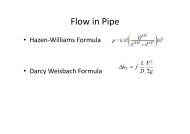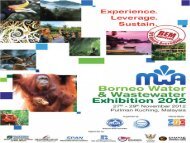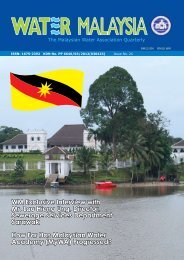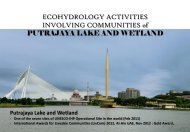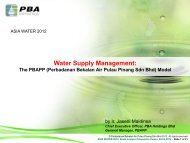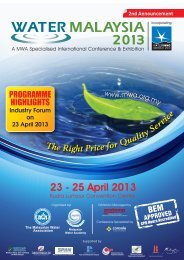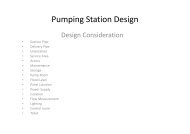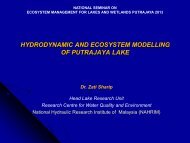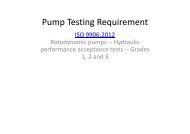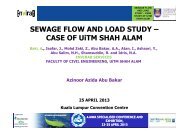Powerpoint template wit - Wageningen UR
Powerpoint template wit - Wageningen UR
Powerpoint template wit - Wageningen UR
- No tags were found...
You also want an ePaper? Increase the reach of your titles
YUMPU automatically turns print PDFs into web optimized ePapers that Google loves.
Attachment and growth of anaerobicconsortia in high salinity wastewatersS.B. IsmailDepartment of Engineering Science,University Malaysia TerengganuTerengganu, Malaysia.
Research backgroundHow it’s produced ?• Produced during several production process;• petroleum• fish & sea-food processing• chemical industries• tanneries and,• textiles.*30 M tons NaCl/year consumed in the EU (chemical industry, agro-foodindustry and road deicing).• Examples;• Canned sardine w/w (8 - 12 gNa + /l)• Petroleum refinery w/w (10 - 11 gNa + /l)• Typical sea water (10.5 gNa + /l)
Research Interest• Ongoing industrial trend: reduction in specific water consumption towards “closedwater loops” leading to accumulation of monovalent cations (Na + ).• Few studies have been so far performed on the application of anaerobic digestion;● Na + conc. exceeding 10g/l strongly inhibit the methanogenesis (Gourdon et al. 1989;Kugelman & McCarty, 1965; Rinzema et al., 1988)● High salinity hampers sludge immobilization and granule formation, negativelyeffecting sludge retention (Mendez et al., 1995)● Anaerobic treatment of saline wastewaters has not been thoroughly studied(Lefebvre and Moletta, 2006).• On the other hand: Stable microbial mats and biofilms frequently occur in marineenvironments (Decho, 2000; Bhaskar & Bhosla, 2005).Technological challenge: transfer of marine environmentsscientific insights to engineered sludge bed systems.
Research BackgroundSNC, Moerdijkthe NetherlandsMSPOZIMPROUASBSEWERSystem performanceDigester Volume (m 3 ) 1430Zimpro effluent flow (m 3 /d) 720Dilution flow (m 3 /d) 720COD Zimpro effluent (g/L) 20Specific loading rate (kgCOD/m 3 .d) 10COD removal efficiency (%) 80Gas production (m 3 /d) 7200
Anaerobic granulesNon-adapted sludgeSalt adapted sludge
SEM micrograph of cross section of initial Shell granules(embedded in a sucrose matrix)
Granules Properties (Shell granules Vs Eerbeek granules )• Less strength• Size, d(0.9) = 0.921 mm• Fluffy• Salinity, 10 g/L Na+• More strength• Size, d(0.9) = 1.605 mm• Dense• Salinity, 0.1 g/l Na+
Effects on Methanogenic sludge(Jeison et al., 2008) (Ismail et al., 2008)(Ismail et al., 2008)
Anaerobic biofilm – exp. design• Objective• To examine the early stages of anaerobic biofilms,grown at different salinity levels using different feedcomposition in order to elucidate the mechanismof initial cell adhesion in the presence of highconcentrations of monovalent cations.© Center for Biofilm Engineering MSU - BOZEMANAnaerobic biofilm reactor
mgCOD/LEffluent COD concentrations4500400035003000Total cells (SYTO 9 stained) for Reactor250020001500100050000 5 10 15 20 25 30 35 40 45Biofilm age (d)R1 R2 R3 R4
Fluorescent in-situ hibridization - CLSMBacteria (red)Archea (yellow)
Fluorescent in-situ hibridization - CLSMReactor R1Reactor R3Reactor R4Bacteria (red)Archea (yellow)
Conclusions• Biofilm formation in the presence of high Na + is feasible.• Appropriate Na/K ratio is prerequisite for rapid developmentand functioning of biofilm reactor at high salinity.• Bacteria and archea was found as microbial colonization in high salinityanaerobic biofilm
AcknowledgementProf. dr. ir, J.B. van Lierdr. ir, H. Temminkdr. ir, C.M. PluggePaula, Christina, Dang, Floor, Fong – W<strong>UR</strong>’ studentsPaques B.V.The NetherlandsBiothane System InternationalThe NetherlandsMinistry of Higher EducationMalaysia



